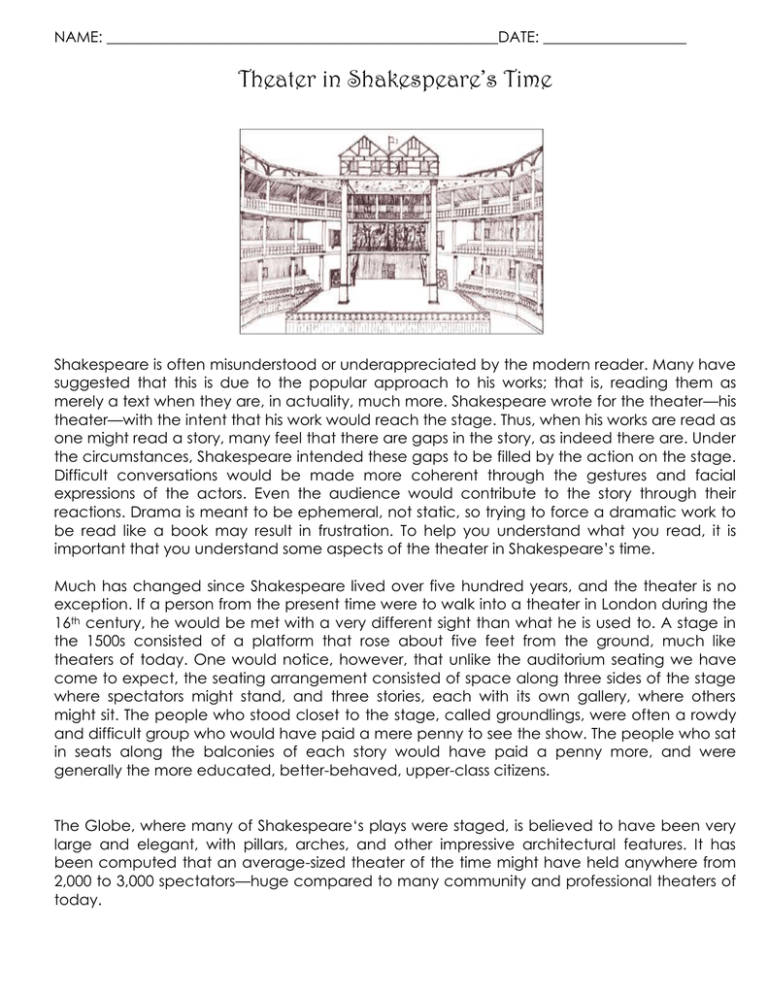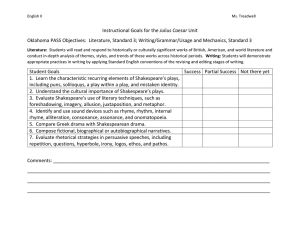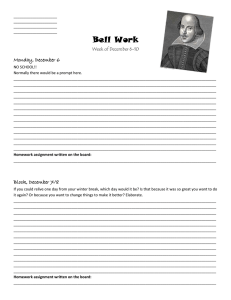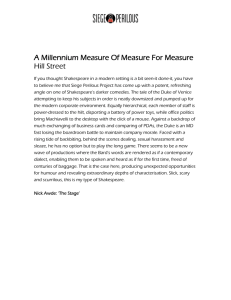8R-Reading Comp Shakespeare Theatre.doc
advertisement

NAME: ____________________________________________________DATE: ___________________ Theater in Shakespeare’s Time Shakespeare is often misunderstood or underappreciated by the modern reader. Many have suggested that this is due to the popular approach to his works; that is, reading them as merely a text when they are, in actuality, much more. Shakespeare wrote for the theater—his theater—with the intent that his work would reach the stage. Thus, when his works are read as one might read a story, many feel that there are gaps in the story, as indeed there are. Under the circumstances, Shakespeare intended these gaps to be filled by the action on the stage. Difficult conversations would be made more coherent through the gestures and facial expressions of the actors. Even the audience would contribute to the story through their reactions. Drama is meant to be ephemeral, not static, so trying to force a dramatic work to be read like a book may result in frustration. To help you understand what you read, it is important that you understand some aspects of the theater in Shakespeare’s time. Much has changed since Shakespeare lived over five hundred years, and the theater is no exception. If a person from the present time were to walk into a theater in London during the 16th century, he would be met with a very different sight than what he is used to. A stage in the 1500s consisted of a platform that rose about five feet from the ground, much like theaters of today. One would notice, however, that unlike the auditorium seating we have come to expect, the seating arrangement consisted of space along three sides of the stage where spectators might stand, and three stories, each with its own gallery, where others might sit. The people who stood closet to the stage, called groundlings, were often a rowdy and difficult group who would have paid a mere penny to see the show. The people who sat in seats along the balconies of each story would have paid a penny more, and were generally the more educated, better-behaved, upper-class citizens. The Globe, where many of Shakespeare‘s plays were staged, is believed to have been very large and elegant, with pillars, arches, and other impressive architectural features. It has been computed that an average-sized theater of the time might have held anywhere from 2,000 to 3,000 spectators—huge compared to many community and professional theaters of today. Behind the stage was the tiring house that served as a versatile backdrop for the shows and where the actors would prepare for the performance. Most scenes would have been staged downstage (closer to the audience) as there was no way to amplify the actors‘ voices at that time. If, however, a scene required a discovery of some kind, a curtain upstage (farthest from the audience) would be used to reveal an actor. There were also doors to the left and right of the stage where actors entered and exited, in addition to trap doors in the floor. Plays were performed during the day, as artificial lighting would have been limited to torches or candles. No scenery was used, so the audience was often forced to use their imagination. Often, a character‘s speech told where and when a scene took place. Props, which were used in abundance, also aided in establishing setting. Actors of the time would have been like today‘s celebrities—dressed in the best styles of the day. Many were rumored to be vagabonds and vagrants—stories that were often embellished to make the actors sound more interesting. Specific actors were known for playing very specific roles, such as the king, or the clown, or the lover, and often plays were written with a certain actor in mind. Women were not allowed to perform publicly; men would have played so all female roles. Plays were written under general categories: tragedy, which ends sadly and often with the demise of the main character; comedy, which ends happily, usually with a wedding or other celebration; history, which dramatizes a fictional historical event; romance, which is a more serious form of comedy with strange, fantastic, or supernatural elements. Most importantly, it is crucial to keep in mind that the meanings of the words tragedy, comedy, history, and romance in the dramatic sense are not the same as the meanings we commonly associate them with today. Tragedy, though serious in its nature, does not necessarily mean that every aspect of the play will be serious in its nature, does not necessarily mean that every aspect of the play will be serious. Comedy, though it often includes humor, does not mean that every scene will be light-hearted and laughable, and in fact, most of Shakespeare’s comedies end-of all things-a wedding. Comprehension Check: Shakespeare’s Theatre Directions: Based upon the article Shakespeare’s Theatre, answer the following questions on a separate sheet of paper using complete sentences. 1. Why do some readers find Shakespeare‘s writing difficult to understand? Explain. How do you feel about Shakespeare‘s language? Why? 2. What would you suggest that a reader do to better prepare himself for Shakespeare‘s writing to make it more understandable? 3. Compare and contrast modern-day theatres to Shakespeare’s time. How are they similar and different? 4. How are today‘s actors or celebrities similar to the actors of Shakespeare‘s time? How are they different?





